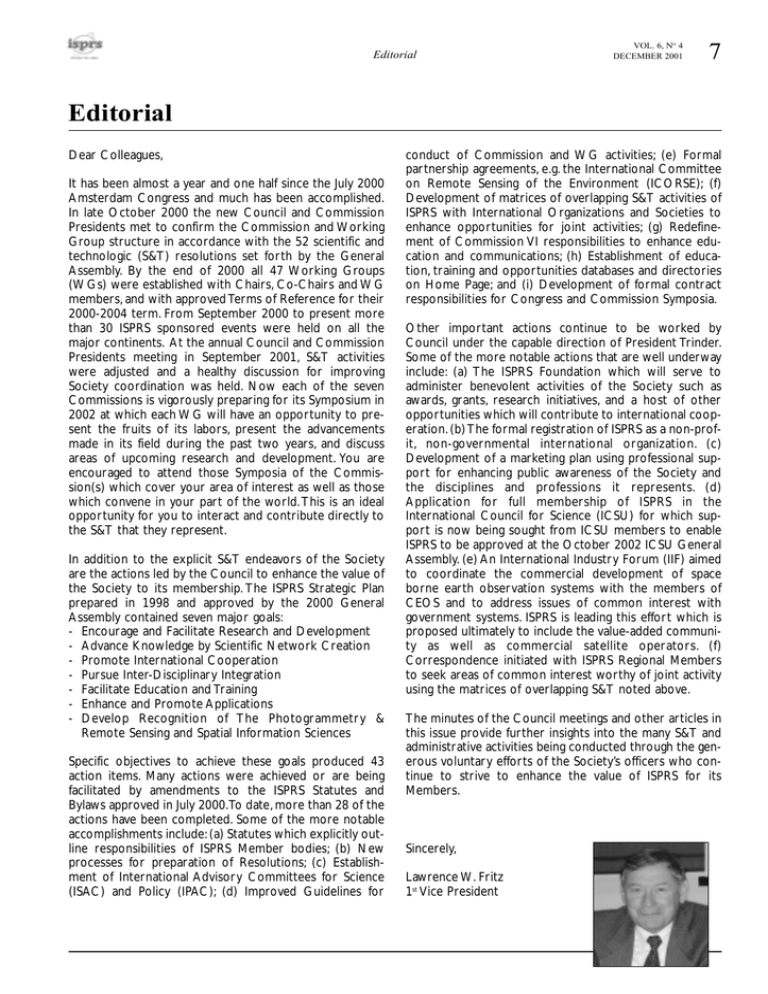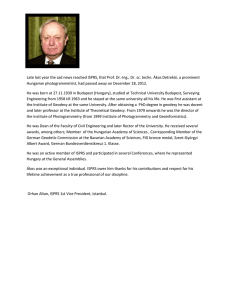7
advertisement

Editorial VOL. 6, NO 4 DECEMBER 2001 7 Editorial Dear Colleagues, It has been almost a year and one half since the July 2000 Amsterdam Congress and much has been accomplished. In late October 2000 the new Council and Commission Presidents met to confirm the Commission and Working Group structure in accordance with the 52 scientific and technologic (S&T) resolutions set forth by the General Assembly. By the end of 2000 all 47 Working Groups (WGs) were established with Chairs, Co-Chairs and WG members, and with approved Terms of Reference for their 2000-2004 term. From September 2000 to present more than 30 ISPRS sponsored events were held on all the major continents. At the annual Council and Commission Presidents meeting in September 2001, S&T activities were adjusted and a healthy discussion for improving Society coordination was held. Now each of the seven Commissions is vigorously preparing for its Symposium in 2002 at which each WG will have an opportunity to present the fruits of its labors, present the advancements made in its field during the past two years, and discuss areas of upcoming research and development. You are encouraged to attend those Symposia of the Commission(s) which cover your area of interest as well as those which convene in your part of the world. This is an ideal opportunity for you to interact and contribute directly to the S&T that they represent. In addition to the explicit S&T endeavors of the Society are the actions led by the Council to enhance the value of the Society to its membership. The ISPRS Strategic Plan prepared in 1998 and approved by the 2000 General Assembly contained seven major goals: - Encourage and Facilitate Research and Development - Advance Knowledge by Scientific Network Creation - Promote International Cooperation - Pursue Inter-Disciplinary Integration - Facilitate Education and Training - Enhance and Promote Applications - Develop Recognition of The Photogrammetry & Remote Sensing and Spatial Information Sciences Specific objectives to achieve these goals produced 43 action items. Many actions were achieved or are being facilitated by amendments to the ISPRS Statutes and Bylaws approved in July 2000.To date, more than 28 of the actions have been completed. Some of the more notable accomplishments include: (a) Statutes which explicitly outline responsibilities of ISPRS Member bodies; (b) New processes for preparation of Resolutions; (c) Establishment of International Advisory Committees for Science (ISAC) and Policy (IPAC); (d) Improved Guidelines for conduct of Commission and WG activities; (e) Formal partnership agreements, e.g. the International Committee on Remote Sensing of the Environment (ICORSE); (f) Development of matrices of overlapping S&T activities of ISPRS with International Organizations and Societies to enhance opportunities for joint activities; (g) Redefinement of Commission VI responsibilities to enhance education and communications; (h) Establishment of education, training and opportunities databases and directories on Home Page; and (i) Development of formal contract responsibilities for Congress and Commission Symposia. Other important actions continue to be worked by Council under the capable direction of President Trinder. Some of the more notable actions that are well underway include: (a) The ISPRS Foundation which will serve to administer benevolent activities of the Society such as awards, grants, research initiatives, and a host of other opportunities which will contribute to international cooperation. (b) The formal registration of ISPRS as a non-profit, non-governmental international organization. (c) Development of a marketing plan using professional support for enhancing public awareness of the Society and the disciplines and professions it represents. (d) Application for full membership of ISPRS in the International Council for Science (ICSU) for which support is now being sought from ICSU members to enable ISPRS to be approved at the October 2002 ICSU General Assembly. (e) An International Industry Forum (IIF) aimed to coordinate the commercial development of space borne earth observation systems with the members of CEOS and to address issues of common interest with government systems. ISPRS is leading this effort which is proposed ultimately to include the value-added community as well as commercial satellite operators. (f) Correspondence initiated with ISPRS Regional Members to seek areas of common interest worthy of joint activity using the matrices of overlapping S&T noted above. The minutes of the Council meetings and other articles in this issue provide further insights into the many S&T and administrative activities being conducted through the generous voluntary efforts of the Society’s officers who continue to strive to enhance the value of ISPRS for its Members. Sincerely, Lawrence W. Fritz 1st Vice President


